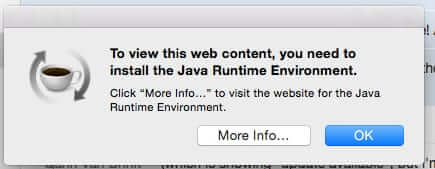Why Do I Need Java to Use Apache OpenOffice?
Java is required for complete OpenOffice functionality. Java is mainly required for the HSQLDBdatabase engine (used by our database product Base) and to make use of accessibility and assistive technologies.Furthermore some wizards rely on Java technology. See additional topics pertaining to the use of Java in OpenOfficeand Apache OpenOffice in theInstallation FAQ.
So what does this mean exactly? Base (the database component) relies completely on Java technologies to run, but otherprograms (like Writer, Calc and Impress) only need Java for special functionality. If you do not need to use Base and donot want to use any of the Wizards, then you do not need to have Java installed and configured for running ApacheOpenOffice (and older versions of OpenOffice.org). You can completely prevent OpenOffice from prompting you about the useof Java by telling OpenOffice not to use a Java runtime environment (JRE). From the OpenOffice main menu use:'Tools - Options... - Java', and uncheck 'Use a Java runtime environment'. However, we do recommendthat you have a JRE on your system to take full advantage of OpenOffice's features without any issues.
Legacy versions of OpenOffice.org 3.3.0 and older included a JRE packaged with the download. Apache OpenOffice3.4.0 and newer do not!
Which Java Version Do I Need to Use Apache OpenOffice?

- Many Adobe applications depend on the Oracle Java Runtime Environment (JRE) for some features to work. Apple recently changed the way it includes Java in Mac OS, and with Lion, Java is no longer preinstalled. It is now an optional install that you must select.
- Java Runtime Environment comes with customizable settings and a variety of features, including some advanced ones such as Java Plug-in, Debugging, Java console, JRE Auto-Download, and more. Java Runtime Environment works smoothly, whether you are using a laptop or a scientific supercomputer, and supports such major platforms as Windows, Linux.
If you want to run Java programs, but not develop them, download the Java Runtime Environment, or JRE™. Important Oracle JDK License Update.
You will need to have a JRE version (32-bit or 64-bit) that is compatible with the architecture of the ApacheOpenOffice version you downloaded. If you already have a JRE installed on your system that satisfies this requirement inone of the standard areas for Java installation, OpenOffice should detect this installation and let you choose it for usein OpenOffice via the 'Tools - Options... - Java'. If you have a JRE installed that is not detected,you should be able to add it through this same menu. And, you can install a JRE or configure OpenOffice to use Java at anytime to get missing functionality to work.
Important note for Windows users:
The Windows version of OpenOffice is 32-bit and therefore it requires a 32-bit JRE. Even when you have a Windows versionwith 64-bit installed.
Furthermore you have to install a 32-bit JRE - additionally or instead - when you already have a64-bit JRE installed.
Where Can I Get Java?
The current versions of Apache OpenOffice work reliably with a variety of JREs includingOracle Java, versions 6, 7 and 8 andopenJDK, versions 6, 7 and 8. Feel free to download a JRE from either of these sitesif you feel you need this functionality.
Please report any problems you experience with using Java on OpenOffice through our bug reporting system,Bugzilla, or one of the other support venues listed in theApache OpenOffice Support webpage, either the users list or forums.
For installing Java on Windows machines, one might appreciate:Download Instructions for Windows offline.
Newest post on how to install Oracle JDK 8 / Java SE 8 on Mac OS X 10.10 Yosemite can be found here.
At the time of this writing, there is no official release of Java SE 7 / Oracle JDK 1.7 on Mac OS X. It is still in developer preview based on Apple’s contributions to OpenJDK. The Developer Preview is provided to the community so that the developers can get feedback on the ongoing progress of the project. The developer preview should work on any Intel-based Mac and has been tested on Mac OS X 10.6.8 (Snow Leopard) and 10.7 (Lion).
UPDATE
Oracle has launched the official Java SE 7 for Mac OS X 64-bit platform. You can download it from here.
This tutorial shows you how to install Java SE 7 Developer Preview on Mac OS X 10.7.2 Lion running on my MacBook Pro.
1. Download the Oracle JDK7 Mac OS X port dmg file from here. At the time of this writing, the version of the JDK7 is Oracle JDK7 build b223 released on December 23, 2011. The dmg file name is jdk-7-ea-macosx-b223.dmg
Java Runtime Environment Windows 10
2. Create a JavaVirtualMachines folder under /Library/Java if it doesn’t exist.
Java Runtime Environment 1.6.0 For Windows 10
In my case, the JavaVirtualMachines is already there so I don’t need to create it manually.
3. Open the jdk-7-ea-macosx-b223.dmg file by double-clicking on it. Then drag the JDK 1.7.0 Developer Preview icon in the left side to the JavaVirtualMachines icon folder in the right side.
Java Runtime Download For Mac
Java Runtime Environment 6.0 Windows
4. Go to /Library/Java/JavaVirtualMachines directory using Finder application. Then double-click the ‘JDK 1.7.0 Developer Preview’ icon. This will open the Java Preferences window. Here you can change the preferred order of the installed Java platforms by dragging it up or down. Make sure the Java SE 7 is in the preferred order or you can simply deselect the Java SE 6 version.
5. Now issue the ‘java -version’ command in the terminal window to verify.

Java Runtime Environment 8
6. Done